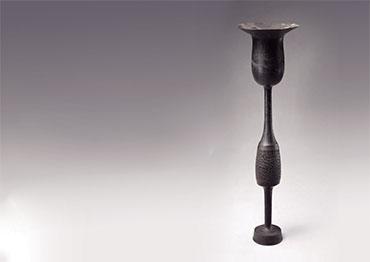In the spring of 1928, famed archaeologist Wu Jinding happened upon a settlement of ancient Chinese people on a riverbank near Longshan Town in Shandong Province during an archaeological survey. It was the site of Chengziya culture – the original excavation site of the Longshan culture. While excavating Chengziya, Wu found pottery fragments that were light and thin but hard as porcelain.
The fragments were measured to be no thicker than 0.2 millimeters. The average thickness of an eggshell is 0.5 millimeters, the size of a syringe needle opening. The thinnest part of the black pottery cup is only 0.2 millimeters, which is more than half as thin as an eggshell. As a result, it was given a new name – black eggshell pottery, which later simply became eggshell pottery.
In its simplest form, pottery is clay formed into shapes and fired. The formula did not change for millennia. Silt and water to make the clay are easy to get. But a chemical reaction takes place during the process. It can be argued that pottery is the earliest use of chemistry and a milestone for human society as it transitioned from the Paleolithic to the Neolithic age. Pottery is an example of ancient wisdom that turned dust into glory.
The earliest known pottery product in the world is a roughly 11 centimeter-tall statue of a naked woman found in the Czech Republic which dates from 29,000 to 25,000 years ago. In China, pottery pieces were unearthed from Xianrendong Cave, or the “Immortal’s Cave” in Chinese, at the foot of Mount Xiaohe, in Wannian County, Jiangxi Province about 20,000 years ago. The fragments are loose and rustic, lacking the firm texture and sheen of ceramics. They look like rough pottery pieces, perhaps part of broken vessels or pots.
Fragments of a ceramic cooking pot were also found at Yuchanyan, an early Neolithic cave site in Dao County, Hunan Province dating back 12,000 to 10,000 years ago. It is worth noting that the earliest archaeological discovery of rice in China was also found at Yuchanyan, and it is reasonable to speculate that the appearance of ceramics as a practical vessel was connected with another significant achievement of human civilization – the agricultural revolution.
After crops were cultivated, ancient people gradually settled on a plot of land. Settlements need pots and jars because grains like millet and rice must be stored and cooked. Storage vessels became increasingly sophisticated. As carrying pots and jars was inconvenient for nomads, pottery utensils varied between farming civilizations and nomadic civilizations.
The agricultural revolution of early humans took place between 10,000 and 8,000 years ago, an era 5,000 to 6,000 years prior to the appearance of eggshell pottery. In the early Chinese prehistoric culture, practicality drove the development of pottery. For example, early ceramic kettles have a round bottom because it was much more difficult to produce a flat one. To remedy the problem, people dug pits to place them in so they would sit flat on the ground. Ancient people would also make a triangle of three stones and put the ceramic kettle or cooking vessel on top.
In the archaeological sites of the early Neolithic, there are many combinations of three stones grouped together that create primitive stoves. It was, however, not always convenient to find three similar stones, so they invented pottery brackets with three legs to cook with. Such an instrument was unearthed at the Wu’anci Mountain site in Hebei Province.

 Old Version
Old Version


